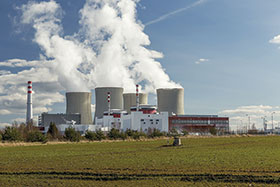

The removal and disposal of spent fuel rods from a nuclear reactor is an extremely precise and controlled process. Used fuel rods are placed at the bottom of a spent fuel pond to begin a process of cooling that will last for years. The highly specialised overhead gantry crane used to transport and position the fuel rods must offer complete reliability. For a recently commissioned crane in the Czech Republic, the OEM chose to specify the NFF Series of compact electromagnetic brakes from Stromag, a premier brand of Altra Industrial Motion.
Every 12 to 24 months, up to one third of the total fuel load of a nuclear reactor is removed from the core. The spent fuel rods, fresh from the core, will be generating immense amounts of heat and radiation that must be controlled and contained locally, prior to being moved into dry casks for final disposal. The spent fuel pond is typically at least 12 metres deep, with temperatures carefully managed to remain below 50°C. The pools contain boric acid for its neutron-absorbing capability, which reduces the ionising radiation emanating from the rods and helps to ensure subcriticality.
When one of Europe’s leading manufacturers of nuclear reactors and related equipment was asked to design a new overhead gantry crane to move spent fuel rods into the pond, it knew that only the most reliable components could be specified. The gantry is used irregularly, often with many days between each operation. As such, critical components such as the motors, winch and brakes must be suited to periods of inactivity without servicing or maintenance. The holding brakes on the winch and the trolley drives are particularly important, as they would only be used in the event of a power failure, at which point they would be required to perform holding duties.
Kay Wendelberger, customer care engineer for Stromag, comments: “Having worked with the manufacturer previously, we were aware of the application demands of such an environment. In addition to requiring a braking system that would operate reliably despite infrequent use, the manufacturer was looking for a compact solution that would provide protection against dust and humidity. The spring-loaded electromagnetic NFF Series provided all the required functionality, including IP66 protection and specialised surface treatment for long term reliability in even the harshest environments.”
The NFF series of double-face, spring-applied brakes were designed to provide reliable braking for applications that are exposed to harsh environments. The double-face design facilitates high braking forces with a compact footprint, which is ideal for crane applications where space is limited. All of the steel components on the brake feature special nitrocarburated and postoxidated surfaces to provide protection against humidity, dust and corrosive materials.
For this particular application, the brakes were required to perform holding duties in the event of a power failure affecting the gantry crane. The crane’s twin trolley drives required multiple NFF 4 brakes with a torque rating of 44 Nm. A single NFF 400 brake was fitted to the winch drive with a torque rating of 4,400 Nm. The spring-applied, electromagnetic brakes are held open while power is supplied to the brake, allowing the crane’s drive system and winch to manage speed and positioning. In the event of a power failure, the brake closes automatically, holding the crane in position while any necessary maintenance or repair work is carried out.
Kay concludes: “The NFF Series is designed to be directly mounted onto the motor’s shaft with no brake disassembly required. This ensures fast installation and minimises the footprint of the application. Our engineers worked closely with the OEM to ensure the models we supplied were best suited to the application and that installation and commissioning occurred without any problems. The gantry crane is now in operation at the nuclear plant and we are working with the manufacturer on other similar projects.”

© Technews Publishing (Pty) Ltd | All Rights Reserved